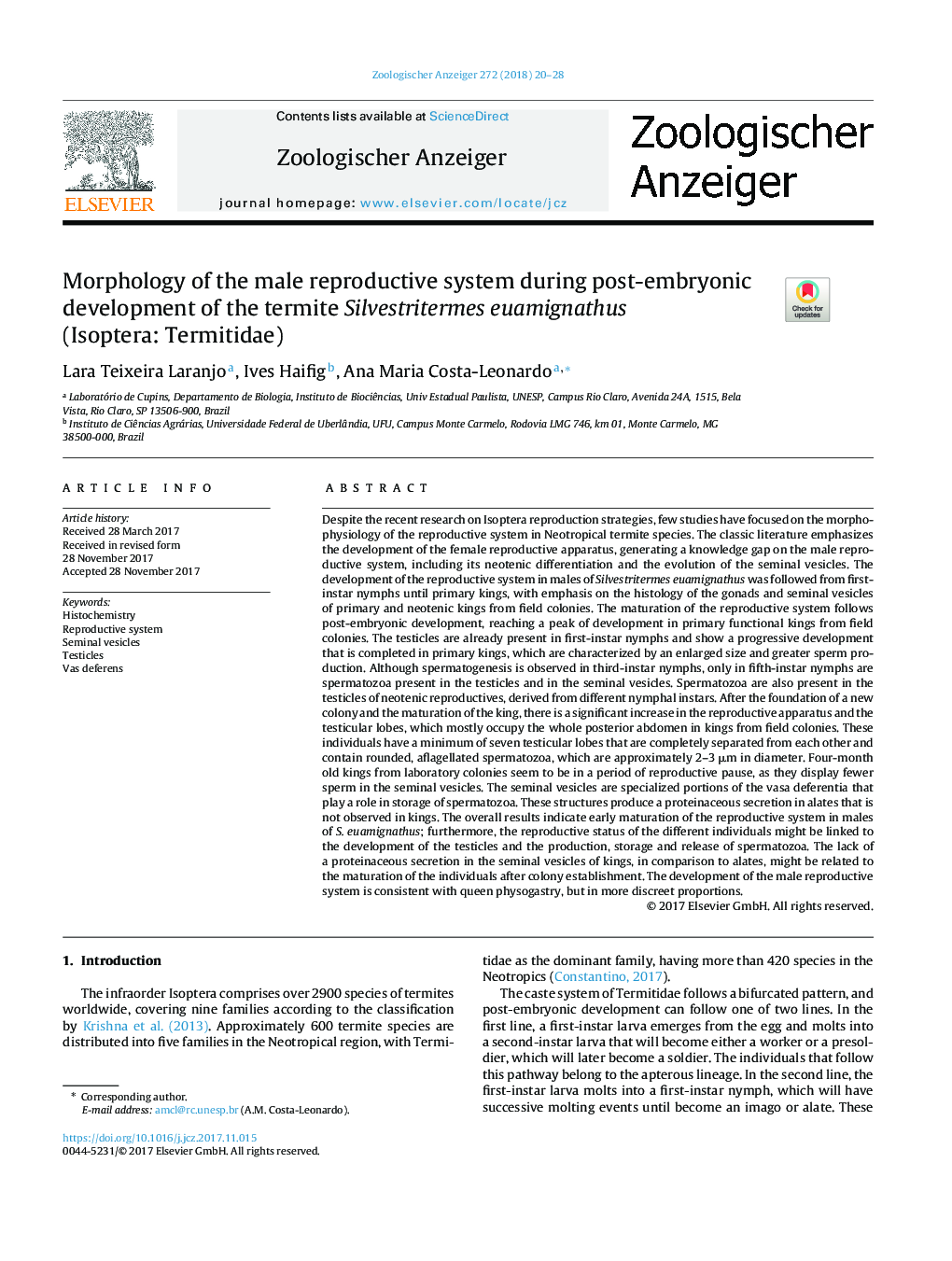| کد مقاله | کد نشریه | سال انتشار | مقاله انگلیسی | نسخه تمام متن |
|---|---|---|---|---|
| 8626841 | 1568603 | 2018 | 9 صفحه PDF | دانلود رایگان |
عنوان انگلیسی مقاله ISI
Morphology of the male reproductive system during post-embryonic development of the termite Silvestritermes euamignathus (Isoptera: Termitidae)
دانلود مقاله + سفارش ترجمه
دانلود مقاله ISI انگلیسی
رایگان برای ایرانیان
کلمات کلیدی
موضوعات مرتبط
علوم زیستی و بیوفناوری
علوم کشاورزی و بیولوژیک
علوم دامی و جانورشناسی
پیش نمایش صفحه اول مقاله

چکیده انگلیسی
Despite the recent research on Isoptera reproduction strategies, few studies have focused on the morphophysiology of the reproductive system in Neotropical termite species. The classic literature emphasizes the development of the female reproductive apparatus, generating a knowledge gap on the male reproductive system, including its neotenic differentiation and the evolution of the seminal vesicles. The development of the reproductive system in males of Silvestritermes euamignathus was followed from first-instar nymphs until primary kings, with emphasis on the histology of the gonads and seminal vesicles of primary and neotenic kings from field colonies. The maturation of the reproductive system follows post-embryonic development, reaching a peak of development in primary functional kings from field colonies. The testicles are already present in first-instar nymphs and show a progressive development that is completed in primary kings, which are characterized by an enlarged size and greater sperm production. Although spermatogenesis is observed in third-instar nymphs, only in fifth-instar nymphs are spermatozoa present in the testicles and in the seminal vesicles. Spermatozoa are also present in the testicles of neotenic reproductives, derived from different nymphal instars. After the foundation of a new colony and the maturation of the king, there is a significant increase in the reproductive apparatus and the testicular lobes, which mostly occupy the whole posterior abdomen in kings from field colonies. These individuals have a minimum of seven testicular lobes that are completely separated from each other and contain rounded, aflagellated spermatozoa, which are approximately 2-3 μm in diameter. Four-month old kings from laboratory colonies seem to be in a period of reproductive pause, as they display fewer sperm in the seminal vesicles. The seminal vesicles are specialized portions of the vasa deferentia that play a role in storage of spermatozoa. These structures produce a proteinaceous secretion in alates that is not observed in kings. The overall results indicate early maturation of the reproductive system in males of S. euamignathus; furthermore, the reproductive status of the different individuals might be linked to the development of the testicles and the production, storage and release of spermatozoa. The lack of a proteinaceous secretion in the seminal vesicles of kings, in comparison to alates, might be related to the maturation of the individuals after colony establishment. The development of the male reproductive system is consistent with queen physogastry, but in more discreet proportions.
ناشر
Database: Elsevier - ScienceDirect (ساینس دایرکت)
Journal: Zoologischer Anzeiger - Volume 272, January 2018, Pages 20-28
Journal: Zoologischer Anzeiger - Volume 272, January 2018, Pages 20-28
نویسندگان
Lara Teixeira Laranjo, Ives Haifig, Ana Maria Costa-Leonardo,